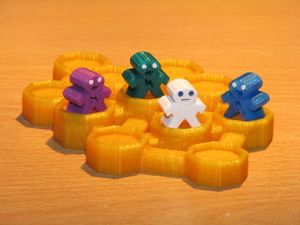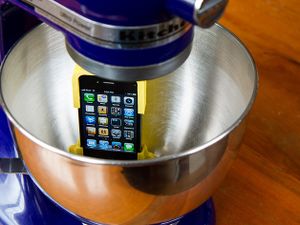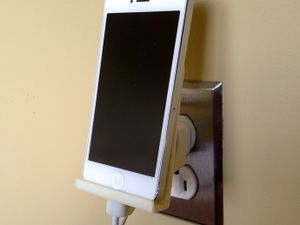User:Jlm5940/Blog
This page contains my blog submissions for EDSGN 497J. Enjoy!
Contents
Blog 1: Thingiverse Designs
Due: 1/22/14
Blog Description: "Go to thingiverse.com and look for printable objects, which other people have actually printed, finding designs which satisfy these descriptions in your mind: something amazing/beautiful, something funny or strange, something useless, something useful, something which surprised you".
Something Amazing/Beautiful
Elephants are my favorite animal, and I love the style of this necklace. I think that the fact that even the chain is printed is pretty amazing. I would probably actually wear this.
Something Funny or Strange
Apparently this is an old game, but I had never heard of it! The little zombie figures made me laugh, mostly because of their facial expressions. Maybe I'll look into how this game works!
Something Useless
I honestly cannot think of a single real use for this accessory. If you watch the YouTube clip they take a video on the phone while the mixer is going, and this is the only purpose I believe this could serve. Using your iPhone to mix ingredients would obviously ruin it. I did enjoy one of the comments on the picture that said "this is what Bill Gates uses to make cookies". It also come with a headphone jack in case you were worried that you couldn't listen to music while your iPhone is being destroyed!
Something Useful
My apartment always seems to lose "chip clips", or we never have enough to go around. Being able to print a bunch of them would be very useful for us. It seems like a fairly simple design, so maybe one day I will be able to make these!
Something Which Surprised You
I didn't really know anything about 3D printing before this class. The reason why this iPhone dock surprised me is because I would have never guessed that something like this could be 3D printed. The fact that functioning technology accessories such as this can be made is incredible, and could save people tons of money.
Blog 2: Open Source Ecology
Due: 2/1/14
Blog Description: "Marcin was just here at PSU talking about his Open Source Ecology project. You may notice or suspect that 3D printers are on his list of systems which should be included in the toolkit. Respond to the following:"
A) General Impressions of OSE
Description: "I want your general impressions of the OSE project; positive, negative, utopian, etc. Please do a bit more research than just viewing the video, as it is now several years old and they have made some progress since then. Links to more recent videos and media will earn you a better blog."
After watching Marcin's TED talk , and several more recent videos of his project's progress, I still find myself having a very torn opinion on his Global Village Construction Set (GVCS) idea. Our society is definitely already entering a recycling and DIY craze. There are several websites and blogs out there that can show the average person how to hand make many everyday items from things that they would already have in their own home or could purchase at a very small cost. Because of this, it is obvious that Marcin's project will become more and more popular. Personally, I think that learning to make what you need on your own is a great idea. It will not only save people a lot of money, but also give them the opportunity to make something that will specifically fit their needs. Marcin first began with making a tractor after his kept breaking down, and building his own that was more durable (and much cheaper) saved him tons of money. I think that using his GVCS for helping third world countries, as he mentioned was one potential use, is a good idea. I do see several problems for the future of this project, however. First of all, Marcin describes the GVCS as a "DIY open source platform that allows for the easy fabrication of the 50 industrial machines that it takes to build a small civilization with modern comforts". I think that when it comes to building machinery, the average person would not consider them to be DIY, easy to fabricate projects. Even as a fairly intelligent person, myself, that is about to graduate with a degree in Mechanical Engineering, a project like this would likely take me a long time with the help of several people. Average people do not have the machining skills required to build any of the GVCS machines. Another problem I foresee, is how it would affect our economy. If everyone would someday begin building all of their own products, it would run so many companies out of business, eliminating millions of jobs. It would, however, save people lots of money. There are so many pros and cons to Marcin's ideas, and quite frankly I cannot pick a side. I think that the best idea, right now, would be for him and his team to continue building these machines and try to use them to start up communities in struggling areas.
B) Response to New Yorker Article and Marcin's Response
Description: "The New Yorker magazine recently had a fairly critical article regarding Marcin's OSE project. Find/link that article and summarize its critique. Marcin had a response to that: I'd like your response to both of these pieces."
Emily Eakin's article, "The Civilization Kit", from The New Yorker both summarizes and criticizes Marcin's GVCS start up and progress thus far. She says that his "following" are more enthusiasts than experts. Another criticism is that his Factor e Farm has no kitchen or bathroom, and barely produces any food. The article then begins to tell the history of Marcin's Open Source Ecology (OCE) ideas. After receiving his PhD, Marcin started the OCE website "with the aim of collecting the best techniques for creating sustainable communities". Marcin and his girlfriend bought a farm and built their own hut to live in. After his tractor repeatedly broke down, he decided to build his own, and quickly realized that he could build everything that he needed in his life. That was the beginning of his GVCS projects. Since then, Marcin has gained quite a following, given an extremely popular TED talk, and inspired others to try to build their own machines. Marcin's goal is to get to the point where he can build a tractor a day.
I don't really think that her article did Marcin's projects any justice. While, it is a news article and they usually focus on the negatives, she didn't even focus on the project as much as she did his personal life. Obviously, the GVCS will cause some controversy, but it seemed as though Eakin was trying too hard to find problems that don't actually exist. The fact that his farm doesn't produce and food, or have a kitchen or bathroom doesn't really matter. From what I have gathered, it's main purpose is a space where Marcin and the Factor e Farm workers can work on building their machines. There are moments where she seemed to praise Marcin's progress, but also tear him down, so I can't quite pinpoint her stance.
Marcin's response to the article basically just defended himself, and his work, in each area that Eakin targeted. I think that he did a good job further describing how they started, what their intentions are, and where they hope to go from here. He explains everything from how the article's title is misleading to how they are bettering the quality of the Factor e Farm's site. As I stated above, I agree with him that Eakin focused too much on his personal life, and the negative outcomes of his work. I don't know that I would go as far as him to say that this Open Source Ecology idea is more critical than trying to end war and environmental injustice, but I do believe that it could help a lot of people.
C) Potential Support at PSU
Description: "Imagine we want to create capabilities similar to what Marcin has made at PSU (something like an OSE student club, or another effort). I don't think the administration or trustees would support such a thing, but there might be professors who are interested in supporting such a thing. Do you know any of them? What do they do, and why do you think they would be interested in such a project? Imagine you are looking for allies to do such a thing. Whom is on your list and why?"
If an OSE club was created here at PSU, I think that there would definitely be student interest. I think that the biggest problem would be to get the materials or funding for the projects, and, at first, I don't see the club actually doing too much each year. Even though Marcin and his team can now assemble his designs in a matter of days, college students are very busy so I think it would take students longer. Getting access to the space and machines would also be an obstacle since there are limited shops to work in (The Learning Factory and Leonard Building being two bigger ones for students to use). I believe that there would definitely be professors interested in support an organization like this. I don't know any that have specifically expressed interest in this area, but professors that have already taken an interest in 3D printing would probably be interested.
Blog 3: Kansas Teen Uses 3-D Printer to Make Hand for Boy
Due: 2/9/14
Blog Description: "Read and respond to this. Who created this design and when/where was it done? If you wanted to make one, where would you go to get it? How many news articles can you find which reference this technology?"
About the Design
This design was originally created by Ivan Owen (theatrical artist who makes parts for puppets) and Richard Van As(a woodworker). Van As came up with the idea after he lost a finger and parts of other fingers during a workshop accident. He wanted a new finger, but didn't want to pay for an expensive prosthetic, so he contacted Owen for help. A mother in South Africa contacted the men, and asked them to build a hand for her son. The Robohand prototype was completed in November of 2012, and the 3-D printer version in January 2013. Designs for this Robohand are open to the public, and can be found on Thingiverse.
Similar Articles
I found several related articles after searching "3-D printed prosthetics" online. One article by the Huffington Post details a similar situation to the one above. This article is about a father that used Owen and Van As as inspiration and printed a hand for his 12 year old son that was born without fingers on his left hand. Another article that I found was from gizmag and features a 17 year old boy, Easton LaChappelle, that created a very advanced 3-D printed prosthetic arm and hand. This invention allowed him to participate in the White House Science Fair, and present his design to President Obama. LaChappelle hopes that his design can be used to help amputees. He was even invited to speak at a TED conference, and the video of his talk can be found here. Finally, I found what I believe to be the most interesting article: 3-D printed eyes. Dezeen magazine's website highlights the British company Fripp Design and Research who claims to be able to print up to 150 eyes per hour. The iris and blood vessels are already included in the printing process, so it eliminates the time it would take for someone to actually paint each eye, which is the current practice. So far, the company has received a lot of interest from India where surgical procedures are not advanced and people are unable to afford expensive prosthetics.
Blog 4: Response to Teammates' and Classmates' Blogs
Due: 2/15/14
Blog Description: "Read your teammates blogs, as well as the blogs of at least 5 other students in class this semester. I would like you to find any thoughtful points made by others which you did not note yourself in Blog 2. (What did your classmates notice which you think worth adding to your own discussion?)"
Response to Teammates' Blogs
I have to give points to Zack for making this assignment much more interesting on a Saturday afternoon. Probably unknowingly, he has also brought to my attention something that I cannot believe I previously overlooked. Marcin's designs could be used to settle on another planet. People have already applied to be the first on Mars with the Mars One non profit foundation (and my friends and I did look a lot into the criteria to be a part of this mission over the summer). Their goal is to train people to travel to Mars and start a human settlement up there. Marcin's designs could possibly be built in space to start the settlements up there.
I agree with Sam's points that the designs are primitive, and that for this to take off, more people outside of OSE need to start "messing with" Marcin's designs. Where I disagree, is that, yes, the designs are primitive to those that have knowledge of tractors, I still don't think that average American's could replicate these designs. Taking my own family as an example, I would maybe name two of them that would have any skills to actually build one of Marcin's designs.
I like that Nate read a lot into the OSE environment. I didn't think about it before, but I do agree that if they would invest in some modern technologies for their workplace, they're process could be improved.
Response to Other Classmates' Blogs
Anthony made an interesting point he doesn't see OSE taking off or being effective in the US as more than a hobby, just more so for underdeveloped countries. I think that if there was more press on this project, people in the US would definitely start taking to it. DIY is a craze right now. I could see a small group of people that enjoy building, taking Marcin's designs, building them, and selling them. It could be the start of a manly, mechanical version of etsy.
Along the same lines, Kevin pointed out that with this being open source, big companies, like MakerBot and John Deere, could begin taking the OSE technology designs and use them to sell cheaper products. I could definitely see this happening.
I enjoyed that Dongao completely disagreed with the OSE project, it was nice to see another opinion. I agree with him in that having people duplicate Marcin's designs could be dangerous. I will reiterate again, most average people do not have the education and skills to do these sorts of projects.
Blog 5: Media Timeline
Due: 2/22/14
Blog Description: "Look through the RepRap Media timeline page and attempt to identify the most significant events from the last few years. If you think there's something missing from the timeline, add it and claim it for XP - but include a summary! What projects continue to recieve coverage/press over time? What projects seem to have slowed or stopped?
Make sure you pick and point out at least one entry which you find: 1) An event very important in the progression of 3D printing technology (open source or not) 2) A not so important event in the progression of this technology (something overhyped perhaps?) 3) Something which you found interesting which you would like to think or speak more about. This might overlap with #1 a bit, depending."
I think that the biggest topic that has continued to receive press over time is 3D printing in the medical field. I, personally, have found some of the articles to be fascinating, and a few of my responses below will touch on that.
1) Scientist Develop Printer to Print Cartilage
Scientists have developed a 3D tissue printer that can print cartilage for implants or to regrow cartilage in joints. So that cartilage cells integrate into the surrounding tissue, an electrospinning machine is used to generate the extremely fine fibers from a polymer solution. I think that this is really important to 3D printing's progression because it is something that can be used on a wide variety of patients and on all parts of the body. This could also be used in cosmetic surgery, potentially decreasing the price. The more discoveries on how 3D printing can be used in the medical field, the more scientists will experiment and find easier solutions to help patients.
2) 3D Printed Shells Save Hermit Crabs
I am probably one of the biggest animal lovers, and love when others try to help animals in need, but I'd have to say something that is a little overhyped is 3D printed hermit crab shells. Until I read the article on the media timeline, I had no idea this was even a problem, so I did some more research and found more articles that prove this point. Yes, it's great that people want to use technology to help the poor hermit crabs that are running out of good shells, but I'm not sure that they have thought it all the way through. The first article even says that sometimes hermit crabs eat part of their shells so having plastic shells would probably not be good for them. Also, I'm not sure how great it would be to fill our oceans with plastic once the crabs die or ditch one of these shells. I could see the idea being good for household pet crabs, maybe, and then the shells that pet stores sell for them can, instead, be thrown into the ocean for the wild ones to use (or something).
3) Researchers Grow Bio-Engineered Human Ear
Researchers at Cornell have created a fully functioning, life-like human ear. Their main purpose for this discovery is to help children born with deformities such as microtia, where they have a fully formed inner ear, but no outer ear is present. The problem with the older methods that is mentioned is that extra cartilage had to be taken from elsewhere on the body to form the ear. With this new method (and with methods I spoke of above in section 1), the full outer ear can be printed in a matter of days. Like I said previously, I think that the medical discoveries will completely change our world. So many people will be able to live more "normal" and easier lives because of some of these scientific break throughs.
Blog 6: The Next Step
Due: 3/1/14
Blog Description: "What projects do you think would be a logical next step for us to pursue? These may be things you see others doing elsewhere, or ideas of your own to push the boundaries of what we are using. We have been putting in significant effort to upkeep the printers we have, but as we get good at that, where might we go next? What would enhance our capabilities or put a new twist on what we are doing? Can we make a composite printer? Do we need more dual extruders everywhere? I know some of you have had ideas on this subject already, so please document them in this blog for everyone."
I think that there is definitely enough interest at Penn State between this class and the 3D printing club that many new projects and ideas can be explored. Dual extruders and composite printers would open up more possibilities. I would like to see more students having access to 3D printers because they have so many applications. As I mentioned in my previous blog, 3D printing is heavily influencing the medical field, and even food science. If Penn State could purchase composite printers, they would have so many more applications. It would help with many student projects so that more intricate objects could be custom designed and fabricated by students instead of having to be purchased. I would love to see, perhaps, the Bioengineering and Food Science majors start to experiment with some of these more advanced printers. It would be awesome to see students at one of the top food science departments start researching how to 3D print more food (maybe there will be 3D printed ice cream at the Berkey Creamery some day?).
It wouldn't be a bad idea to have either more 3D printing classes available, or have the club teach more students how to use the printers. It might also be useful for them to put together a "how to" guide on using and fixing these printers. I will for sure admit that I am no where near an expert on how these printers work, and since, for most of us, every little issue is guess and check and ask the internet, a sort of instruction manual would be very beneficial.
Blog 7: Responses to Articles About New 3D Printing Technology
Due: 3/8/14
Response to "3D printing could offer developing world savings on replica lab kit"
Blog Description: "Read this. What do you think about this idea? Can you think of any examples of cheap research equipment we have made?"
As I have mentioned in previous blogs, I am still very much on the fence about mass distributing 3D printers. It is a wonderful that we have discovered the ability to manufacture things at 25% of the cost (example in the article is printing a calorimeter for $50 instead of $2000). I agree with Pearce, however, that "with the advent of 3D printers, companies relying on extracting monopoly prices on products for which there is already an equivalent open-source alternative must either reduce their margins or continue to innovate to remain economically viable". I know it sounds horrible for me to say that these kinds of things because one might think I don't want to help those less fortunate, which is something this article really hits on. This is really why I can't decide how I feel about this new technology. The article says that it is important for these technologies to be available, and not hidden behind intellectual property rights, to poor communities. It would be great to help these poor communities, but, like the article says, these countries need to be able to support the funding of this technology. Can they really afford that? Of course, it is much cheaper, but the question is, is this what they should be spending their money on? It's not a question I can really answer.
This article shows a few pieces of equipment that have already been 3D printed for a fraction of the "real" cost. Some examples include pipettes and test tubes. The designs for most of these can be found on Thingiverse.
Response to "How to build a low-cost AFM nanoscope out of LEGO + Arduino board"
Blog Description: "Read this. What do you think of this? Does it seem printable to you? Why or why not? Relate it back to the first article. Discuss the importance (or lack thereof) of open source in this."
This article was very brief, and pretty vague. It states that "low-cost scientific instrumentation is can be a huge enabler for hospitals and clinics in developing countries", which is similar to what the previous article discussed. This LEGO2NANO initiative allowed students to demonstrate functionality of one of the AFMs in just five days. If students could do this in five days, imagine what professionals could do given some time and access to this technology. I found another article about this program that gives some more details about it. One thing that it mentions is how these nanoscopes can be used to study the affects of air pollution, something that China really needs to work on. If more people had access to this, more scientists, or even students, could be studying pollution or even viruses.




